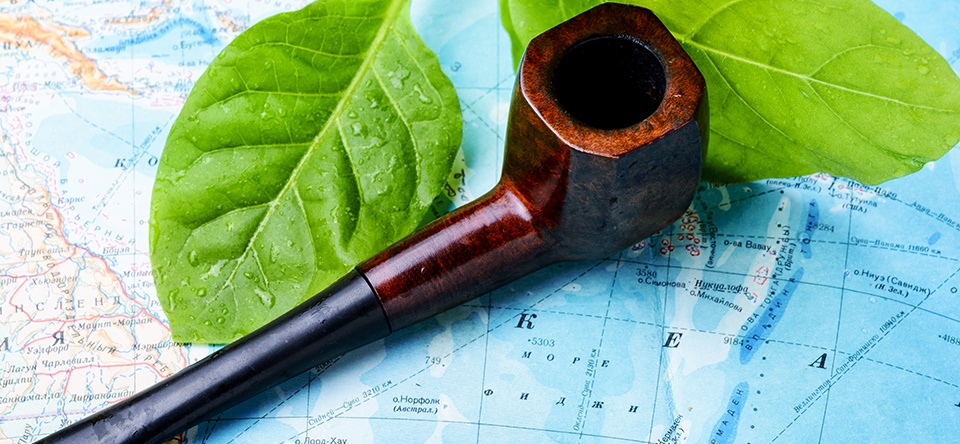
Tobacco has played an important role in the history of the United States. From the Colonial plantations that allowed American trade to prosper, to the decades where doctors would prescribe tobacco for weight loss, the plant has proliferated in popularity and remains a major aspect of society today. Artifacts that celebrate this extensive and interesting history are now in vogue, and demand top dollar by tobacco enthusiasts and antique collectors alike.
Quick, Robin: To The Man Cave!
1992 saw an influx of cigar demand that no-one could have anticipated. Cigar Aficionado, an impressive, glossy publication began circulating the same year and is credited for helping amplify the growing demand for premium cigars by easing the stigma associated with the product. No longer were cigars to be seen as relics from a by-gone era of scientific infancy: the magazine bolstered the portrayal of cigar smokers as refined aristocrats – and the industry followed.
Well-known figures like William Shatner and Larry King began espousing their love for fine cigars, and soon, in-home smoking lounges and room-sized humidors began to be common offerings in the homes of celebrities and industry leaders. Tobacco lounges for the public became more commonplace, too.
These new lounges – in public or at home – needed decorating, and Tobacciana, the term used to describe collectibles and antiques related to tobacco, began fetching impressive prices at auction. Tobacciana includes anything from advertisements sporting images of smoking Doctors to prohibition-era cigar vending machines. The latter is an interesting artifact once popular for helping secret bars, or speakeasies, maintain discretion. These portable gambling machines known as trade-stimulators would dispense cigars as prizes and could justify a crowded bar so long as the booze was sufficiently hidden. Today these simple machines can fetch tens of thousands of dollars in the right condition.
The Original Color-Changing Pipe
Another article prized by collectors is the Meerschaum Pipe. The pipes are made of sepiolite: a white clay mineral composite. The soft stone had been used for elaborate decorative carvings for centuries, but by 1723 its light and porous nature was discovered to be perfectly suited for pipe production. The tiny holes in the material leach moisture from the dank tobacco and produce a rich, smooth smoke at a cooler temperature than wood and clay pipes.
Sepolite is so porous that it is often found floating on the Black Sea. It’s striking appearance and unusual maritime location led Abraham Gottlob Werner to coin a new name for the material (and the pipe) in 1788: Meerschaum, literally German for “foam of the sea.”
The pores that make sepiolite so valuable as a sort of filter also have a fringe cosmetic benefit: they cause the pipe to change color. It takes time and quite a bit of smoke, but tobacco oils caught in the pipe eventually darken the outer appearance into a myriad of colors – yellow, orange, red and amber – that give the pipe a character of woody age adored by enthusiasts. Meerschaum pipes are still sought after for their ideal smoking qualities, but by the 1820s another material started to compete for the favor of pipe smokers worldwide.
Briar Root Pipes, Still the Standard Today
Briar pipes are made from the root of the flowering plant known as Erica arborea, “tree heath” or more commonly “the giant heather.” The root produces an unusually tight grain that makes for a very durable and well-insulated pipe. Traditionally, the pipes go through an elaborate process to be made that starts by harvesting, at the youngest, a fifty-year-old plant. After careful woodworking, the root of the plant is boiled for several hours to remove sap and then left to sit drying for up to two years. Then, the pipe carving can begin. The hard wood presents the smoker with a durability incomparable to clay or meerschaum pipes – a quality which compels its popularity to this day. Many briar pipes are made with industrialized processes today, but the unique beauty of the knotted wood still shines through, even in the most affordable varieties.
Smoking Venues
Tobacco smoking is a long-held and sociable tradition is many cultures and as a consequence, shops to consume the herb in public come in a wide variety from all corners of the globe.
Hookah use for tobacco is thought to have originated in India after tobacco was introduced there by the Jesuits. This style of consumption offers several unique aspects to the user: not only is the smoke cooled and filtered by water, but the tobacco itself is flavored with concentrated fruit syrups that make for a unusually palatable smoking experience. Cafes that serve Hookah have transcended their cultural origin and are now popular on college campuses and in metropolitan cities around the world.
Cigar lounges have also become increasingly popular in recent decades and offer accommodations for perhaps a more demanding crowd. In-store humidors are kept at precise temperatures and humidity to maintain the qualities of premium aged tobaccos, and massive ventilation systems adorn the rooms, sucking out rolling clouds of smoke so effectively that it’s hard to smell a neighbor’s cigar burning just feet beside you.
The most modern venue for tobacco (or, at least nicotine) consumption is the vape shop. These come in a variety of incarnations as the regulations for the use of electronic cigarettes are still catching up to the market. As of now, many retailers of the product function as an ad hoc lounge to vaporize their wares as well. Some retailers offer actual lounges for vaping at their store, while others just encourage “free product demonstrations” where a potential buyer can try the product before purchase.
From water pipes popularized by Persian Princes to modern devices that give you the sensation of smoking without the smoke – whatever your preference, in today’s market you’re sure to find something you’ll enjoy.
